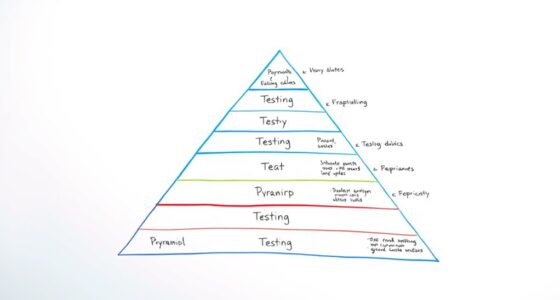As Agile development continues to evolve, it becomes clear that improving QA practices is a significant hurdle for many teams. The rapid iterations and emphasis on customer value can make traditional QA methods seem outdated in comparison to Agile principles.
However, the quest for efficient and effective QA practices in Agile development is far from a simple task. It requires a nuanced understanding of how to seamlessly integrate QA into the iterative Agile process while maintaining a sharp focus on delivering high-quality software.
In this discussion, we’ll explore key strategies and best practices that can help us navigate this complex terrain and elevate the role of QA in Agile development.
Key Takeaways
- Collaborative testing approach promotes open communication and shared responsibility between testers and developers.
- Test automation strategies streamline testing processes, enhance efficiency, and improve overall software quality.
- Continuous integration and delivery facilitate frequent code integration, automated testing, and accelerated software delivery.
- Agile metrics and reporting provide quantitative insights into project progress and quality, helping identify bottlenecks and drive continuous improvement.
Agile QA Process Overview
In our Agile development process, the QA team collaborates closely with all stakeholders to ensure early and continuous testing, fostering rapid issue identification and resolution for higher-quality product delivery within shorter timeframes.
Agile methodologies emphasize flexibility and collaboration, enabling the QA team to engage in continuous testing throughout the software development lifecycle. This approach emphasizes the importance of early involvement, collaboration, and continuous feedback for efficient defect detection and resolution.
Agile QA practices involve close collaboration between team members and stakeholders, prioritizing enhanced customer satisfaction. By prioritizing higher-quality product delivery in a shorter timeframe, Agile methodologies enable the QA team to adapt to changing requirements and deliver value to the end user.
The Agile QA process overview highlights the importance of adaptive development processes, where flexibility and collaboration are core principles. This approach ensures that the QA team plays a pivotal role in fostering rapid issue identification and resolution, ultimately contributing to the successful delivery of high-quality software products.
Collaborative Testing Approach

Collaborative testing approach fosters open communication, shared responsibility, and joint problem-solving among testers, developers, and stakeholders throughout the software development process. This approach is essential in Agile methodologies as it promotes iterative testing, continuous feedback, and a culture of collaboration.
Here’s how collaborative testing approach enhances the QA process in Agile:
- Enhanced Communication and Collaboration: Testers actively engage with developers to identify and address issues in real time, ensuring that the software meets quality standards at every stage of development.
- Iterative and Incremental Testing: By working together, testers and developers can continuously test and refine the software, leading to early issue detection and resolution, which is crucial in Agile testing.
- Continuous Feedback Loop: Stakeholders contribute to a holistic testing approach by providing valuable input and feedback, ensuring that the software aligns with user needs and expectations.
Test Automation Strategies
Test automation strategies complement the collaborative testing approach by streamlining testing processes and enhancing the efficiency of iterative and incremental testing in Agile development. By leveraging automation, our team can achieve continuous testing, ensuring that changes to our products are assessed thoroughly and efficiently. This not only saves time but also allows us to obtain rapid feedback, enabling us to address issues promptly and deliver high-quality products to our customers.
Automated testing tools enable us to complete a larger number of tests, contributing to improved overall software quality. Implementing test automation in our Agile QA process fosters collaboration among different teams, optimizing resource utilization and reducing costs. It also allows our team to focus on more complex scenarios that require human intuition and creativity, while repetitive manual testing is handled by automation.
Embracing test automation aligns with our Agile approach, enabling us to meet customer expectations for quick iterations and high-quality deliverables.
Continuous Integration and Delivery

As we optimize our QA practices in Agile development, we prioritize the implementation of Continuous Integration and Delivery (CI/CD) to streamline code integration and automate software deployment processes. CI/CD plays a pivotal role in Agile projects, ensuring continuous testing and feedback, thus enhancing the overall quality of the software.
Here’s how CI/CD is instrumental in Agile software development:
- Frequent Code Integration: CI/CD enables the swift integration of code changes into a shared repository, promoting an iterative approach and reducing the risk of integration challenges during the later stages of development.
- Automated Testing: CI/CD facilitates automated testing, which is indispensable in an Agile environment. It allows for the early detection of bugs, ensuring that the software remains in a deployable state at all times.
- Continuous Deployment: By automating deployment processes, CI/CD accelerates the delivery of software, aligning with the fast-paced nature of Agile methodology. This not only increases development speed but also reduces the manual effort required for deployment, thus optimizing QA practices in Agile development.
Incorporating CI/CD practices into Agile projects significantly enhances the efficiency and reliability of the software development process, aligning with the core principles of Agile methodology.
Agile Metrics and Reporting
After optimizing our QA practices in Agile development through the implementation of Continuous Integration and Delivery (CI/CD), we pivot to the critical aspect of Agile Metrics and Reporting, which provides quantitative insights into project progress and quality.
Agile Metrics and Reporting are crucial for QA professionals as they offer a data-driven approach to evaluate the effectiveness of Agile practices in the software development process. These metrics encompass various key indicators such as velocity, sprint burndown, defect density, and test coverage.
By actively reporting on these metrics, we can identify bottlenecks, enhance processes, and make informed decisions to drive continuous improvement.
In Agile development, the use of Agile Metrics and Reporting becomes instrumental in assessing the success of project delivery and in steering the overall quality assurance efforts. It allows us to gauge the impact of test automation, the thoroughness of test cases in relation to user stories, and the correlation with customer satisfaction.
Frequently Asked Questions
How to Improve Testing Quality in Agile?
Improving testing quality in Agile involves continuous collaboration, proactive testing, and automation.
We prioritize early and ongoing QA involvement, allowing for prompt defect detection and customer satisfaction.
By implementing Agile methodologies such as TDD, ATDD, and BDD, we enhance testing efficiency.
Our approach emphasizes stakeholder collaboration, which leads to better test case identification and issue resolution.
Continuous testing and feedback during each sprint facilitate a faster feedback loop and timely issue resolution.
How Do You Ensure Quality Assurance in Agile?
We ensure quality assurance in agile by:
- Integrating testing throughout the development process
- Prioritizing continuous feedback
- Leveraging diverse testing methodologies like TDD, ATDD, and BDD.
Our team:
- Collaborates closely
- Automates testing processes
- Focuses on early error detection
This enables us to deliver high-quality products efficiently. Additionally, we emphasize the importance of:
- Clear entry/exit criteria
- High-level testing scenarios
These elements are included in our Agile Test Plan to maintain a robust quality assurance framework.
How Can QA Process Be Improved?
Improving the QA process requires continuous refinement and adaptation. We prioritize early involvement in sprint planning and user story refinement, fostering effective communication and collaboration.
Test automation is utilized for comprehensive testing, and we actively participate in Agile retrospectives to share insights and improve the process.
Our emphasis on early detection and prompt issue resolution ensures that we address issues early in the development process, optimizing our QA practices in Agile development.
What Is the QA Environment in Agile?
In Agile, the QA environment is dynamic, emphasizing continuous testing and collaboration with developers. Tests are prioritized like user stories, and automated testing tools amplify our testing capabilities.
This approach ensures rapid feedback and promotes software quality. Our team thrives in this environment, constantly refining our processes to deliver high-quality products.
Conclusion
In conclusion, optimizing QA practices in Agile development is like fine-tuning a symphony orchestra, where each member plays their part to create a harmonious and high-quality performance.
By implementing collaborative testing, test automation strategies, continuous integration and delivery, and agile metrics and reporting, we can ensure that our software development process operates at its peak efficiency and produces top-notch results.
Together, we can achieve excellence in Agile QA.









